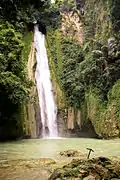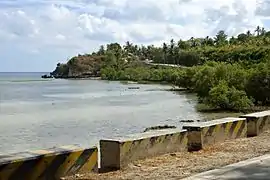Barili
Barili, officially the Municipality of Barili (Cebuano: Lungsod sa Barili; Tagalog: Bayan ng Barili), is a 2nd class municipality in the province of Cebu, Philippines. According to the 2015 census, it has a population of 73,862 people. [3]
Barili | |
|---|---|
| Municipality of Barili | |
 Poblacion | |
 Flag | |
 Map of Cebu with Barili highlighted | |
OpenStreetMap 
| |
.svg.png.webp) Barili Location within the Philippines | |
| Coordinates: 10°07′N 123°32′E | |
| Country | |
| Region | Central Visayas (Region VII) |
| Province | Cebu |
| District | 3rd District |
| Founded | 1632 |
| Barangays | 42 (see Barangays) |
| Government | |
| • Type | Sangguniang Bayan |
| • Mayor | Julieto N. Flores |
| • Vice Mayor | Luisito Ponsica |
| • Representative | Pablo John F. Garcia |
| • Electorate | 49,761 voters (2019) |
| Area | |
| • Total | 122.21 km2 (47.19 sq mi) |
| Elevation | 92 m (302 ft) |
| Population | |
| • Total | 73,862 |
| • Density | 600/km2 (1,600/sq mi) |
| • Households | 15,679 |
| Economy | |
| • Income class | 2nd municipal income class |
| • Poverty incidence | 30.43% (2015)[4] |
| • Revenue | ₱145,272,827.87 (2016) |
| Time zone | UTC+8 (PST) |
| ZIP code | 6036 |
| PSGC | |
| IDD : area code | +63 (0)32 |
| Climate type | tropical rainforest climate |
| Native languages | Cebuano Tagalog |
History
The word barili comes from the name of a local grass called balili. The municipality was founded in 1632, though the parish of Barili was established in 1614. A cross was erected by conquistadores on their arrival at 1602, and still exists today.
It was in Barili that the Japanese forces captured Chief Justice José Abad Santos while on his way to Toledo as his escape route to Negros.
In 2006, the town became the first municipality in Cebu province to give protections to its heritage sites through Municipal Ordinance No. 04-06-01, s. 2006, declaring certain shrines, houses, buildings, monuments, markers and other areas as cultural properties of the municipality.
Geography
Barili is bordered to the north by the town of Aloguinsan, to the west is the Tañon Strait, to the east is the city of Carcar and the town of Sibonga, and to the south is the town of Dumanjug.
Barangays
Barili comprises 42 barangays:
| PSGC | Barangay | Population | ±% p.a. | |||
|---|---|---|---|---|---|---|
| 2015 [3] | 2010 [5] | |||||
| 072210001 | Azucena | 2.8% | 2,061 | 1,647 | 4.36% | |
| 072210002 | Bagakay | 1.2% | 904 | 824 | 1.78% | |
| 072210003 | Balao | 3.3% | 2,446 | 1,776 | 6.28% | |
| 072210004 | Bolocboloc | 3.0% | 2,226 | 1,932 | 2.73% | |
| 072210005 | Budbud | 2.2% | 1,628 | 1,513 | 1.40% | |
| 072210006 | Bugtong Kawayan | 1.1% | 800 | 719 | 2.05% | |
| 072210007 | Cabcaban | 2.6% | 1,922 | 1,543 | 4.27% | |
| 072210016 | Cagay | 2.5% | 1,813 | 1,568 | 2.80% | |
| 072210008 | Campangga | 2.0% | 1,455 | 1,481 | −0.34% | |
| 072210020 | Candugay | 2.4% | 1,777 | 1,443 | 4.04% | |
| 072210009 | Dakit | 2.5% | 1,864 | 1,672 | 2.09% | |
| 072210010 | Giloctog | 2.2% | 1,589 | 1,502 | 1.08% | |
| 072210012 | Giwanon | 2.5% | 1,830 | 1,608 | 2.49% | |
| 072210011 | Guibuangan | 3.1% | 2,303 | 2,212 | 0.77% | |
| 072210013 | Gunting | 3.9% | 2,861 | 2,566 | 2.09% | |
| 072210014 | Hilasgasan | 1.0% | 747 | 863 | −2.71% | |
| 072210015 | Japitan | 5.2% | 3,821 | 3,527 | 1.54% | |
| 072210017 | Kalubihan | 1.9% | 1,403 | 1,197 | 3.07% | |
| 072210018 | Kangdampas | 1.5% | 1,077 | 955 | 2.32% | |
| 072210021 | Luhod | 1.3% | 955 | 917 | 0.78% | |
| 072210022 | Lupo | 0.9% | 673 | 614 | 1.76% | |
| 072210023 | Luyo | 1.5% | 1,091 | 1,071 | 0.35% | |
| 072210024 | Maghanoy | 1.7% | 1,265 | 1,077 | 3.11% | |
| 072210025 | Maigang | 2.7% | 1,978 | 1,688 | 3.06% | |
| 072210026 | Malolos | 2.4% | 1,742 | 1,617 | 1.43% | |
| 072210027 | Mantalongon | 4.0% | 2,988 | 2,566 | 2.94% | |
| 072210028 | Mantayupan | 3.1% | 2,317 | 2,092 | 1.96% | |
| 072210029 | Mayana | 1.7% | 1,250 | 1,075 | 2.91% | |
| 072210030 | Minolos | 3.2% | 2,399 | 2,311 | 0.71% | |
| 072210031 | Nabunturan | 1.0% | 774 | 684 | 2.38% | |
| 072210032 | Nasipit | 1.6% | 1,172 | 1,030 | 2.49% | |
| 072210034 | Pancil | 1.6% | 1,153 | 890 | 5.05% | |
| 072210035 | Pangpang | 1.3% | 995 | 853 | 2.98% | |
| 072210036 | Paril | 1.7% | 1,241 | 1,137 | 1.68% | |
| 072210037 | Patupat | 2.5% | 1,850 | 1,663 | 2.05% | |
| 072210038 | Poblacion | 7.0% | 5,141 | 4,808 | 1.28% | |
| 072210039 | San Rafael | 2.2% | 1,654 | 1,157 | 7.04% | |
| 072210040 | Santa Ana | 2.8% | 2,087 | 2,045 | 0.39% | |
| 072210041 | Sayaw | 1.8% | 1,298 | 1,090 | 3.38% | |
| 072210042 | Tal‑ot | 2.5% | 1,876 | 1,639 | 2.60% | |
| 072210043 | Tubod | 2.9% | 2,176 | 1,889 | 2.73% | |
| 072210044 | Vito | 1.7% | 1,260 | 1,063 | 3.29% | |
| Total | 73,862 | 65,524 | 2.31% | |||
Climate
| Climate data for Barili, Cebu | |||||||||||||
|---|---|---|---|---|---|---|---|---|---|---|---|---|---|
| Month | Jan | Feb | Mar | Apr | May | Jun | Jul | Aug | Sep | Oct | Nov | Dec | Year |
| Average high °C (°F) | 29 (84) |
30 (86) |
31 (88) |
32 (90) |
31 (88) |
30 (86) |
30 (86) |
30 (86) |
30 (86) |
29 (84) |
29 (84) |
29 (84) |
30 (86) |
| Average low °C (°F) | 22 (72) |
22 (72) |
23 (73) |
24 (75) |
25 (77) |
25 (77) |
24 (75) |
24 (75) |
24 (75) |
24 (75) |
24 (75) |
23 (73) |
24 (75) |
| Average precipitation mm (inches) | 42 (1.7) |
34 (1.3) |
40 (1.6) |
61 (2.4) |
124 (4.9) |
188 (7.4) |
190 (7.5) |
191 (7.5) |
189 (7.4) |
186 (7.3) |
124 (4.9) |
73 (2.9) |
1,442 (56.8) |
| Average rainy days | 10.0 | 8.5 | 9.5 | 12.8 | 22.3 | 26.8 | 28.4 | 27.9 | 27.3 | 27.6 | 20.5 | 13.1 | 234.7 |
| Source: Meteoblue (Use with caution: this is modeled/calculated data, not measured locally.)[6] | |||||||||||||
Demographics
|
| |||||||||||||||||||||||||||||||||||||||||||||
| Source: Philippine Statistics Authority [3] [5] [7][8] | ||||||||||||||||||||||||||||||||||||||||||||||
Economy
Barili is an agricultural town, and its economic output is more on food security. Farming and animal husbandry are the main livelihood of people residing in the town. They focus on rice and corn farming, animal husbandry such as hog, cattle and poultry, fruit farming and even vegetable gardening. Barili has its established Mantalongon Livestock Market[9] where you can buy live animals which collectively come from Southern parts of Cebu and even from Negros Province. Barili is also known for its Japitan Fish Port.[10] located in Barangay Japitan, 4–5 km away from its public market. Barangay Guiwanon of the same town is known for production of hand-weaved 'native hats made from leaves of the buri tree and other weaved native products.[11]
Tourism
Mantayupan Falls are located close to the eastern end of the Carcar—Barili Road where it connects to the national highway.[12] The falls are approximately 61 metres (200 ft) high but do not have a direct descent. Pools at various heights flow into the basin. The waterfall is one of three main tourist attractions in the interior barangays of Barili.[13]
Gallery
 Mantayupan Falls
Mantayupan Falls Tañon Strait coast at Barili
Tañon Strait coast at Barili Historic houses in Barili
Historic houses in Barili
References
- Municipality of Barili | (DILG)
- "Province: Cebu". PSGC Interactive. Quezon City, Philippines: Philippine Statistics Authority. Retrieved 12 November 2016.
- Census of Population (2015). "Region VII (Central Visayas)". Total Population by Province, City, Municipality and Barangay. PSA. Retrieved 20 June 2016.
- "PSA releases the 2015 Municipal and City Level Poverty Estimates". Quezon City, Philippines. Retrieved 12 October 2019.
- Census of Population and Housing (2010). "Region VII (Central Visayas)". Total Population by Province, City, Municipality and Barangay. NSO. Retrieved 29 June 2016.
- "Barili: Average Temperatures and Rainfall". Meteoblue. Retrieved 10 May 2020.
- Censuses of Population (1903–2007). "Region VII (Central Visayas)". Table 1. Population Enumerated in Various Censuses by Province/Highly Urbanized City: 1903 to 2007. NSO.
- "Province of Cebu". Municipality Population Data. Local Water Utilities Administration Research Division. Retrieved 17 December 2016.
- "Ground Breaking Ceremony of the Mantalongon Livestock Market | Facebook". www.facebook.com. Retrieved 2019-03-01.
- "fish port japitan barili cebu - Google Search". www.google.com. Retrieved 2019-03-01.
- "Mother continues business for workers". Philippine Daily Inquirer. Retrieved 2019-03-01.
- 10°6′24″N 123°31′16″E
- Cabigas 2011.
Sources
- Cabigas, Estan (29 September 2011), "Visiting Mantayupan Falls after 23 years" (Photographic essay), Langyaw, archived from the original on 1 October 2011, retrieved 12 February 2015
- Pace, Azucena (2009). Barili The Town The People The Years, A History. Cebu: Local Government Unit of Barili, Cebu. ISBN 978-9719441601.CS1 maint: ref=harv (link)
External links
![]() Media related to Barili, Cebu at Wikimedia Commons
Media related to Barili, Cebu at Wikimedia Commons